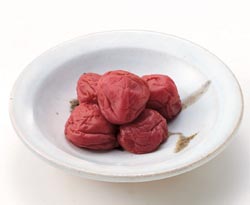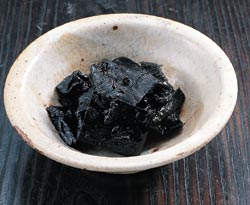|
Special Feature*
Sesame
 |
Two of the many ways to eat sesame are to sprinkle the seeds whole on rice balls, or to grind the seeds into a powder that is then used as a topping for vegetables. The coating of black sesame seeds contains a pigment called anthocyanin, which is now attracting attention for its reported ability to slow down the cell aging process.
|
Umeboshi (pickled Japanese apricot)
 |
To make umeboshi, ume Japanese apricots are pickled in salt, dried, mixed with beefsteak plant leaves, then pickled again. They are tucked inside rice balls (one for each ball), or eaten as a snack with tea. Umeboshi are quite acidic, so when you chew one the mouth releases more saliva. Human saliva contains plenty of a hormone called parotin, which is said to slow down the aging process.
|
Sardines
 |
Sardines are plentiful and cheap, and are eaten by many Japanese. The best way to supplement your diet with their calcium is to dry them in the sun, grill, and then eat them whole, head and all. They contain DHA, EPA and large quantities of nucleic acid, all said to help prevent memory loss and dementia.
|
Kombu seaweed tsukudani
 |
Tsukudani is seaweed with fish or shellfish that has been flavored with soy sauce and simmered in mirin sweet saké and sugar. Tsukudani keeps well. It has a pronounced taste, so it goes well with plain rice. When kombu seaweed is soaked in water it emits a gooey substance. This substance contains not only fucoidan, which strengthens the immune system and reduces cholesterol, but also alginic acid, which removes toxic substances from the intestines.
|
|
Eat Fish and Live Longer: Research Findings from the Shiga University of Medical Science
A health study conducted from 1980 to 1999 found that men who eat fish at least once every two days reduce their risk of dying from illnesses such as heart disease or stroke by about 30%, compared with men who eat fish less than once a week. Nakamura Yasuyuki, an associate professor at Shiga University of Medical Science, used more than 9,000 people for his study.
Of the 9,252 people (4,070 men, 5,182 women) covered by the 19-year study, 1,835 died (995 men, 840 women). With the death risk for men who ate fish less than once a week used as an index of 1.00, men who ate fish at least once every two days had a death risk of 0.70; once a day, 0.75; and at least twice a day, 0.67. This shows that eating fish fairly frequently offers the chance of living longer.
The findings show that people who eat more fish tend to reduce their risk of dying from cardiac arrest or stroke. No obvious difference was noted for women, perhaps because women in the age groups studied have a lower death rate than men, in any case.

|
|